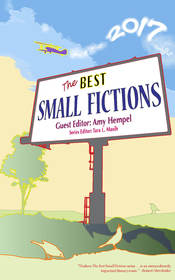
Editor’s note: We are fortunate to have Tara L. Masih, founding series editor for the Best Small Fictions anthology, guest blog for us this week. Tara takes a look at some of her favorite endings from flash fictions included in the BSF series.
Anyone who studies or participates in writing sudden, flash, or micro fiction knows the importance of a great ending. As Henry Wadsworth Longfellow so accurately said: “Great is the art of the beginning, but greater is the art of the ending.” Longfellow, who mostly published poetry and translated some of the world’s greatest writers, understood that leaving the reader with an indelible image or deep new understanding makes for a more powerful and resonant reading experience. In other words, exiting a story well is more important than how we enter. And it may be more difficult to achieve. With that in mind, here are my top choices for perfect endings from the Best Small Fictions series. Needless to say, choosing was a hard task. I believe every story in each volume accomplishes what Longfellow emphasizes, but these six have something extra special.
2015, guest edited by Robert Olen Butler:
1. “Let’s Say” by Julia Strayer, originally published in SmokeLong Quarterly (watch here)
This flash is a one-paragraph tour de force that hits the reader hard with a strong opening, then takes the reader on a journey that’s both internal and external. Strayer avoids the expected narrative direction that a victim story might normally take and moves us toward a conclusion that reaches above the victim’s, and our, basic instincts. “Let’s Say” was mentioned in many reviews and I think that’s a testament, of course, to the story as a whole but also to its powerful ending.
2. “The Garden Sky,” by Dave Petraglia, originally published in Necessary Fiction (Nov. 26, 2014)
One of the hardest things to do in any genre, but especially within the confines of flash, is to tackle subjects as large and complex as race relations, bias, and guilt of the conqueror/invader. Petraglia manages to cover all of these heavy themes in two pages. His narrator is a white businesswoman admiring a young female Vietnamese civil engineer during a work lunch. A lunch discussing apps that recognize bombs, which are unearthed and cleaned and sold in markets. Bomb is a heavy word in this story, with multiple layers of meaning for both parties. The ending is a masterful, poetic rewind of the bombs that fell on the engineer’s country, injuring her father. It’s tortuous because we cannot do rewinds on dropped bombs, and I think the ending helped put this story on many readers’ lists of favorites.
2016, guest edited by Stuart Dybek:
3. “Bug Porn,” by Robert Scotellaro, originally appeared in What We Know So Far (Blue Light Press)
Leaving readers with a strong visual image is one way to ensure they will remember your story. In this humorous Micro, Scotellaro uses visual interplay between a husband and wife to set up a strong statement. A daddy longlegs, squished on the ceiling, is not just a dead bug. Scotellaro narrows the focus of vision to a single insect leg, which angled just so, looks like a “forward slash. With all of the surrounding grammar missing.” The power is in the image, and in the space around the image, as it relates to the couple’s marriage.
4. “The Story, Victorious,” by Etgar Keret, originally appeared in Flash Fiction International (W. W. Norton)
Another humorous ending. Or is it an ending? Keret fools the reader into thinking he or she has reached one ending, but then produces another. Masterful and original, and got him recognition in the venerable Flash series.
2017, guest edited by Amy Hempel:
- “Sea Air,” by Matt Sailor, originally appeared in Five Points, Vol. 17, No. 3
Sailor’s brief almost post-apocalyptic story proves that an ending can be very simple, yet still be powerful. His final line is a fragment of just five words: “A tangle of disturbed sheets.” It’s both visual and metaphorical. Each word chosen carefully. This editor appreciated every word and nuance. The reader will, too.
- “In Our Circle,” by Kimberly King Parsons, originally from NANO Fiction, Vol. 10
Parsons’ ending is not only visual, but tactile. She manages to literally mold an ending that invests lumps of clay with Freudian symbolism and her narrator’s deepest thoughts and flaws. This little story is already getting attention in reviews. She has a great beginning, but an even greater ending.
For other great endings, see the individual stories recommended by the Flash Field Guide authors and editors in the downloadable PDF at Rose Metal Press’s website. The PDF will be available later this fall.
 Tara Lynn Masih is editor of two ForeWord Books of the Year, The Rose Metal Press Field Guide to Writing Flash Fiction and The Chalk Circle: Intercultural Prizewinning Essays, and is author of Where the Dog Star Never Glows. Her flash appears in many anthologies, including Flash Fiction Funny, Flashed: Sudden Stories in Comic and Prose, and W. W. Norton’s forthcoming New Micro: Exceptionally Short Fiction, and was featured in Fiction Writer’s Review for National Short Story Month. Additional awards include The Ledge Magazine’s Fiction Award, the Lou P. Bunce Creative Writing Award, a Wigleaf Top 50 and a Neville Award citation, and Pushcart Prize, Best New American Voices, and Best of the Web nominations. She is Founding Series Editor for The Best Small Fictions annual anthology and received a finalist fiction grant from the Massachusetts Cultural Council.
Tara Lynn Masih is editor of two ForeWord Books of the Year, The Rose Metal Press Field Guide to Writing Flash Fiction and The Chalk Circle: Intercultural Prizewinning Essays, and is author of Where the Dog Star Never Glows. Her flash appears in many anthologies, including Flash Fiction Funny, Flashed: Sudden Stories in Comic and Prose, and W. W. Norton’s forthcoming New Micro: Exceptionally Short Fiction, and was featured in Fiction Writer’s Review for National Short Story Month. Additional awards include The Ledge Magazine’s Fiction Award, the Lou P. Bunce Creative Writing Award, a Wigleaf Top 50 and a Neville Award citation, and Pushcart Prize, Best New American Voices, and Best of the Web nominations. She is Founding Series Editor for The Best Small Fictions annual anthology and received a finalist fiction grant from the Massachusetts Cultural Council.

 The core workshop of SmokeLong Fitness is all in writing, so you can take part from anywhere at anytime. We are excited about creating a supportive, consistent and structured environment for flash writers to work on their craft in a community. We are thrilled and proud to say that our workshop participants have won, placed, or been listed in every major flash competition. Community works.
The core workshop of SmokeLong Fitness is all in writing, so you can take part from anywhere at anytime. We are excited about creating a supportive, consistent and structured environment for flash writers to work on their craft in a community. We are thrilled and proud to say that our workshop participants have won, placed, or been listed in every major flash competition. Community works.